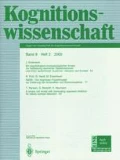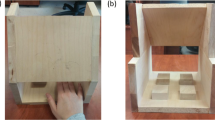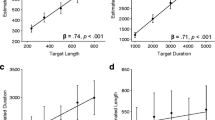Abstract
The present paper provides evidence for a differential involvement of spatial and visual mental resources in propositional and spatial reasoning. Two experiments consider the load on visuospatial working memory during reasoning. Subjects solve propositional and spatial reasoning tasks either alone or in combination with visual tracking. In the first experiment, subjects resource allocation strategy is manipulated. Independently of the allocation of mental resources to the reasoning tasks or the tracking task, tracking is found to interfere much more with spatial than with propositional reasoning. In the second experiment, propositional reasoning after a comprehension training is disrupted by a simultaneous secondary spatial task, but not by the visual tracking task.
Zusammenfassung
Die vorliegende Arbeit liefert Hinweise für eine unterschiedliche Beteiligung räumlicher und visueller Ressourcen beim aussagenlogischen und räumlichen Schlußfolgern. Zwei Experimente zur Belastung der visuell-räumlichen Komponente des Arbeitsgedächtnisses beim Schlußfolgern werden vorgestellt. Versuchspersonen lösen aussagenlogische und räumliche Schlußfolgerungsaufgaben alleine und in Kombination mit visuellem Zielverfolgen. Im ersten Experiment wird das Verhältnis manipuliert, in dem mentale Ressourcen den beiden simultan zu bearbeitenden Aufgaben zugeordnet werden. Unabhängig von der Zuordnung mentaler Ressourcen stören sich Zielverfolgen und Schlußfolgern gegenseitig beim räumlichen, weniger deutlich aber beim aussagenlogischen Schließen. Im zweiten Experiment erweist sich das aussagenlogische Schlußfolgern nach einem Verständnistraining für aussagenlogische Prämissen als anfällig gegenüber einer gleichzeitig bearbeiteten räumlichen Zweitaufgabe, nicht aber gegenüber dem visuellen Zielverfolgen.
Similar content being viewed by others
Literatur
Baddeley, A.D. (1986) Working memory. Oxford: Clarendon Press.
Baddeley, A.D. & Hitch, G. (1974) Working memory. In: G.H. Bower (Ed.), The psychology of learning and motivation. Vol. 8 (pp. 47–90) New York: Academic Press.
Bauer, M. I. & Johnson-Laird, P.N. (1993) How diagrams can improve reasoning. Psychological Science 4, 372–378.
Byrne, R.M.J. & Johnson-Laird, P.N. (1989) Spatial reasoning. Journal of Memory and Language 28, 564–575.
Erickson, J.R. (1974) A set analysis theory of behavior in a formal syllogistic reasoning task. In: R.L. Solso (Ed.), Theories in cognitive psychology: The Loyola symposium (pp. 305–330) Potomac, MD: Lawrence Erlbaum.
Erickson, J.R. (1978) Research on syllogistic reasoning. In: R. Revlin & R.E. Mayer (Eds.), Human reasoning (pp. 39–50) Washington, DC: Winston.
Evans, J. S. B.T. (1984) Heuristic and analytic processes in reasoning. Br J Psychol 75, 451–468.
Evans, J. S. B.T. (1989) Bias in human reasoning: Causes and consequences. Hillsdale, NJ: Lawrence Erlbaum.
Evans, J. S. B.T. & Brooks, P.G. (1981) Competing with reasoning: A test of the working memory hypothesis. Current Psychological Research 1, 139–147.
Farmer, E.W., Berman, J.V., & Fletcher, Y.L. (1986) Evidence for a visuo-spatial scratch pad in working memory. Q J Exp Psychol 38A, 675–688.
Ford, M. (1994) Two modes of mental representation and problem solution in syllogistic reasoning. Cognition 54, 1–71.
Gilhooly, K. J., Logie, R.H., Wetherick, N.E., & Wynn, V. (1993) Working memory and strategies in syllogistic-reasoning tasks. Mem Cognit 21, 115–124.
Glenberg, A.M., Kruley, P., & Langston, W. E. (1994) Analogical processes in comprehension. In: M.A. Gernsbacher (Ed.), Handbook of psycholinguistics (pp. 609–640) New York: Academic Press.
Guyote, M.J. & Sternberg, R.J. (1981) A transitive chain theory of syllogistic reasoning. Cognitive Psychology 13, 461–525.
Hitch, G.J. & Baddeley, A. (1976) Verbal reasoning and working memory. Q J Exp Psychol 28, 603–621.
Johnson-Laird, P.N. (1983) Mental models: Toward a cognitive science of language, inference, and consciousness. Cambridge: Cambridge University Press.
Johnson-Laird, P.N. (1985) Deductive reasoning ability. In: R.J. Sternberg (Ed.), Human abilities: An information processing approach (pp. 173–194) New York: Freeman.
Johnson-Laird, P.N. & Byrne, R.M.J. (1991) Deduction. Hillsdale, NJ: Lawrence Erlbaum.
Johnson-Laird, P. N. & Byrne, R.M.J. (1993) Mental models or formal rules? Behavioral and Brain Sciences 16, 368–380.
Johnson-Laird, P. N., Byrne, R.M.J., & Schaecken, W. (1992) Propositional reasoning by model. Psychol Rev 99, 418–439.
Kirby, K.N. & Kosslyn, S.M. (1990) Thinking visually. Mind and Language 5, 324–341.
Klauer, K.C. (1994) Zur Modelltheorie des aussagenlogischen Schlußfolgerns: Zeitliche Faktoren beim Konstruieren und Anwenden mentaler Modelle. Sprache und Kognition 13, 1–26.
Klauer, K.C. & Oberauer, K. (1995) Testing the mental model theory of propositional reasoning. Q J Exp Psychol 48a, 671–687.
Klauer, K. C., Oberauer, K., Roßnagel, C. & Musch, J. (1996) Mentale Modelle und mentale Bilder. Zeitschrift für Psychologie 204, 41–54.
Klauer, K.C. & Stegmaier, R. (1997) Interference in immediate spatial memory: Shifts of spatial attention or central-executive involvement? Q J Exp Psychol 50A, 79–99.
Klauer, K. C., Stegmaier, R. & Meiser, T. (1997) Working-memory involvement in propositional and spatial reasoning. Thinking and Reasoning 3, 9–47.
Logie, R.H. (1995) Visuo-spatial working memory. Hove, UK: Lawrence Erlbaum.
Logie, R.H. & Marchetti, C. (1991) Visuo-spatial working memory: Visual, spatial or central executive? In: R.H. Logie & M. Denis (Eds.), Mental images in human cognition (pp. 105–115) Amsterdam: North-Holland.
MacLennan, B. J. (1993) Visualizing the possibilities. Behavioral and Brain Sciences 16, 356–357.
Navon, D. & Gopher, D. (1979) On the economy of the humanprocessing system. Psychol Rev 86, 214–255.
Norman, D.A. & Bobrow, D.G. (1975) On data-limited and resource- limited processes. Cognitive Psychology 7, 44–64.
Oakhill, J.V. & Johnson-Laird, P.N. (1984) Representation of spatial descriptions in working memory. Current Psychological Research and Reviews 3, 57–62.
Pylyshyn, Z.W. & Storm, R.W. (1988) Tracking multiple independent targets: Evidence for a parallel tracking mechanism. Spatial Vision 3, 179–197.
Quinn, J.G. & McConnell, J. (1996) Indications of the functional distinction between the components of visual working memory. Psychologische Beiträge 38, 355–367.
Smyth, M.M. (1996) Interference with rehearsal in spatial working memory in the absence of eye movements. Q J Exp Psychol 49, 940–949.
Smyth, M.M. & Scholey, K.A. (1994) Interference in immediate spatial memory. Mem Cognit 22, 1–13.
Stenning, K. & Oberlander, J. (1995) A cognitive theory of graphical and linguistic reasoning: Logic and implementation. Cognitive Science 19, 97–140.
Toms, M., Morris, N. & Foley, P. (1994) Characteristics of visual interference with visuospatial working memory. Br J Psychol 85, 131–144.
Toms, M., Morris, N., & Ward, D. (1993) Working memory and conditional reasoning. Q J Exp Psychol 46A, 679–699.
Vandierendonck, A. & De Vooght, G. (1996a) Working memory constraints on linear reasoning with spatial and temporal contents. Zur Veröffentlichung eingereichtes Manuskript.
Vandierendonck, A. & De Vooght, G. (1996b) Working memory usage in four-term deductive reasoning problems with simultaneous or sequential presentation of premise terms. Reports of the department of general psychology 29. Ghent: Belgien.
Wickens, C.D. (1984) Engineering psychology and human performance. Columbus, OH: Bell & Howell.
Yantis, S. (1992) Multielement visual tracking: Attention and perceptual organization. Cognitive Psychology 24, 295–340.
Author information
Authors and Affiliations
Corresponding author
Additional information
Der Verfasser dankt den Herren Dipl.-Psych. Thorsten Meiser, Dipl.-Psych. Jochen Musch und Dr. Christian Roßnagel für die Erhebung der Daten. Die vorliegende Arbeit wurde von der Deutschen Forschungsgemeinschaft durch Projekt KL 615/5-1 gefördert.
Rights and permissions
About this article
Cite this article
Klauer, K.C. Visuelle und räumliche Interferenzen beim Schlußfolgern. Kognit. Wiss. 7, 11–18 (1998). https://doi.org/10.1007/BF03354958
Published:
Issue Date:
DOI: https://doi.org/10.1007/BF03354958




